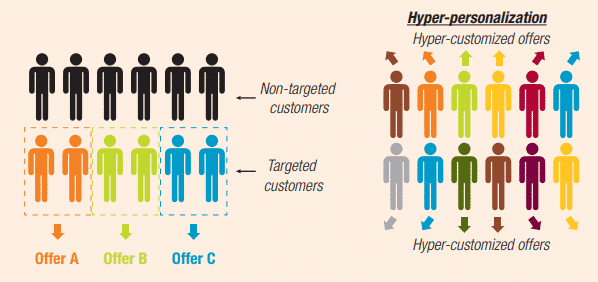AI, machine learning, and big data have touched every industry and have been embraced by B2B marketers. AI allows marketers to locate the right buyers and reach them at the right moment with the right offer. Marketing in the past often required a fair amount of guesswork, but the ability to process and crunch large datasets to identify nuanced customer needs gives marketers a leg up.
Personalisation has evolved from broad-based targeting to increasingly sophisticated one-on-one engagement. That said, far too many marketers expect that technology will be able to handle all of their outbound marketing needs. They also underestimate the need for human oversight. Marketing messages and content developed without a human touch are often generic and do not align with brand values. Clients or customers who receive too much of this content will likely ignore or block a business.
Using AI-powered tools to advance hyper-personalisation requires the right amount of business savvy and human ingenuity. Here are five easy ways B2B marketers can better utilise AI and hyper-personalisation to build their business and customer relationships.
1) Evolve B2B personalisation beyond traditional boundaries
The journey from basic segmentation to sophisticated AI-driven personalisation requires a realistic understanding of capabilities and limitations. While B2C personalisation has advanced from broad segments to individualised recommendations based on demographics and behavior, B2B personalisation has lagged behind, historically focusing on simplistic factors like company size and industry. Modern approaches must transcend outdated tactics like generic title-based outreach (“As VP of marketing, you struggle with…”), which executives now recognise as spam.
Effective B2B personalisation incorporates buyer intent signals, historical engagement patterns, and addresses complex multi-stakeholder purchase decisions where no single person holds complete authority. Vendors should preemptively understand business challenges and recommend tailored solutions based on industry challenges, research behaviors, and buying journey position – recognising that AI tools alone won’t transform results overnight without this deeper contextual understanding.
2) AI strategy must align with brand values
In the era of AI-powered outreach, a troubling trend has emerged among B2B companies: mass automation without meaningful connection. This AI “abuse” manifests as companies scraping hundreds of thousands of email addresses and bombarding prospects with generic messages—a practice that doesn’t build sustainable business and actively damages brand reputation.
The consequences of this approach are becoming increasingly apparent. LinkedIn recently cracked down on data scraping across their platform, with major players like Apollo and Seamless banned for violating terms and conditions. Even Google has modified its spam policy to exclude AI-generated clickbait from search results.
When businesses implement AI strategies that push thousands of generic messages across a target account list of 100 companies, they rapidly burn through potential audiences while delivering poor customer experiences. Many of these messages never reach intended recipients, as sophisticated screening tools block them preemptively.
This approach ignores what B2B buyers actually want: personalised experiences delivered with transparency. This creates what we might call the “privacy paradox” – buyers seek personalisation while expressing legitimate concerns about data collection practices. Resolving this tension requires transparent value exchange approaches that respect customer boundaries.
As third-party tracking limitations increase, first-party data strategies have become essential. This places greater emphasis on direct customer relationships and consensual data collection rather than invasive scraping techniques.
3) Align AI metrics with buyer values
The most successful B2B organisations—those seeing the greatest ROI from personalisation—are integrating marketing, sales, and customer success data to create consistent experiences across the entire customer lifecycle. Their approach uses AI to enhance human connections rather than replace them. The fundamental principle remains: treat customers respectfully by approaching them thoughtfully. Use AI tools to facilitate meaningful human interaction, not eliminate the need for genuine conversation and relationship-building. Just because technology enables you to email 1,000 people in a day doesn’t mean you should.
When measuring AI’s business impact, focus on precise frameworks that honor the B2B buyer journey. Move beyond simplistic engagement metrics to track extended sales cycles, pipeline generation, and average deal times. Remember that most B2B buyers use AI themselves and aren’t afraid of the technology—they simply expect ethical implementation, transparent value exchange, and consensual data practices that prioritise direct relationships over excessive collection.
Timeless principles and new tools
AI is evolving by the second and hyperpersonalisation will likely look different by the end of the year than it does now. Some principles, however, are timeless. Respect buyers. Reach out to someone only when something could truly help or be useful. Remember that technology that doesn’t have a human minder can be as much of a problem as a solution. B2B organisations seeing the most significant returns from personalisation are those that follow these principles and integrate marketing, sales, and customer success data to create consistent experiences throughout the customer lifecycle.


 Whether you want to learn how to use LinkedIn, X or Facebook for marketing, or need to brush up on business skills like leadership, presentation skills or managing meetings, you will find something to enhance your professional skills with these on-demand courses.
Whether you want to learn how to use LinkedIn, X or Facebook for marketing, or need to brush up on business skills like leadership, presentation skills or managing meetings, you will find something to enhance your professional skills with these on-demand courses.